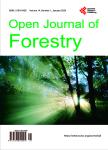Quantitative Evaluation of Bitterlich Sampling for Estimating Basal Area in Sparse Boreal Forests and Dense Tropical Forests
Quantitative Evaluation of Bitterlich Sampling for Estimating Basal Area in Sparse Boreal Forests and Dense Tropical Forests作者机构:Center for Environmental Remote Sensing Chiba University Chiba Japan Department of Environmental Geochemical Cycle Research Japan Agency for Marine-Earth Science and Technology Yokohama Japan Faculty of Life and Environmental Sciences University of Tsukuba Tsukuba Japan
出 版 物:《Open Journal of Forestry》 (林学期刊(英文))
年 卷 期:2017年第7卷第2期
页 面:143-156页
学科分类:1002[医学-临床医学] 100214[医学-肿瘤学] 10[医学]
主 题:Angle-Count Sampling Basal Area Forest Structure Modeling Boreal Forests Tropical Forests
摘 要:Bitterlich sampling is an extensively used technique in worldwide forest inventories. Although it has been proved that estimates of basal area from Bitterlich sampling are mathematically unbiased, its precision for individual forest stands may be fairly poor. An extension of validation efforts to different forest biomes could therefore provide more comprehensive assessment and understanding of the Bitterlich sampling technique. In this study, this technique was quantitatively evaluated by using simulated sparse boreal forests and dense tropical forests from an empirical forest structure model (EFSM). Theoretical estimation of basal areas and practical estimation influenced by the hidden-tree effect were both compared with true basal areas of the simulated forests. The evaluation results indicated that: 1) Bitterlich sampling can yield acceptable accuracy and precision when the count number (CN) of trees was set to 10 for the studied boreal and tropical forests with distinct characteristics, 2) the theoretical estimation of basal area can be improved by increasing the CN values for both forests, and 3) when the hidden-tree effect is encountered, the accuracy for tropical forests will be decreased by increasing the CN values, whereas the accuracy for boreal forests can still be improved. Accordingly, a relatively high CN, at a reasonable cost, is recommended for sparse boreal forests to improve the accuracy of basal area estimation. In contrast, for dense tropical forests, a CN of ten is appropriate to mitigate the hidden-tree effect.



